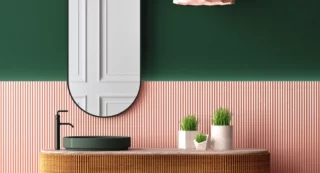Your Simple Guide to Hanging Picture Frames
You can make any house into a home by adding finishing touches, including by selecting and hanging picture frames.
This is your chance to stamp your personality on a room.
Your individual choice of photographs, paintings, prints and wall art can transform the space and create whatever effect you want. Whether you have plain walls and stripped back spaces, or elaborate decors to fill.
However, have you ever walked into someone’s home and found your eyes drawn to their walls for the wrong reasons? Badly hung pictures stand out like a sore thumb. The poor placement of an item can be more memorable than its contents!
When hanging picture frames, thought and planning are needed. It ensures that you do justice to the picture contents and create a pleasing effect.
Location, location
The starting point is deciding the best place to hang picture frames. It can be an excellent idea to prop a picture up, in roughly the right location, for a few days. Give yourself time to see it in different light variations and at different times of day.
It could be that after consideration, you want to rethink its location or specific placement.
Or, you may decide that your chosen spot is perfect. And you are ready to fix the picture permanently to the wall.
Picture frame placement tips
Hanging picture frames in the perfect place is clearly a lot to do with personal preference. This includes not just the art you chose to include, but how it appears too.
For example, some homeowners, interior designers or architects love to make big bold statements. This could mean a large framed picture placed front and centre in a room. As soon as you enter, your attention is drawn to this statement.
Having a single, striking piece of work mounted in your room can involve careful planning on lighting. You may want to place the picture under spotlights for example, or opposite a window that creates a good supply of natural light.
Other people prefer hanging picture frames in a less minimalist way. They enjoy having a mixture of pictures, or coordinate themes and colour schemes across multiple walls.
How these are placed is also a matter of personal taste. You could hang pictures anywhere you want, including in asymmetrical or even random arrays. That can be a great way of placing pictures to match up with room features and furniture.
There is also the option to cluster pictures together, or space them evenly around the room.
Can you mix traditional and classic frames with modern designs? Of course you can! If that eclectic style suits the overall theme of the room. It’s about what you want to see and love.
Keep in mind though, that getting carried away with creative placement can lead to picture hanging errors.
For example, a cluster of images in a confined space can make it look cluttered and “smaller”. Or, a dark, bold and impressive painting can lose a lot of its effect if it’s placed in a corner or a poorly lit location. Equally, a smaller picture in pastel shades can “disappear” if placed in a solo spot on an empty wall.
Also, it’s advisable to hang pictures around eye level, rather than too high or low, to fully appreciate them.
It all comes back to experimenting and considering before permanent fixing, as mentioned above.
Type of frames
Once you have selected your preferred location, hanging picture frames to best effect depends on the type you have chosen.
Browsing the range of frames offered by Memory Box shows you the creative options, styles and colours you can select to match your picture and its location. That goes from shabby chic and ornate, to contemporary and sleek.
Frames and borders also vary in size and structure, providing picture hanging options. If you don’t know what frame size best fit your picture read our picture frame size guide.
For example, some pictures in lighter frames lend themselves well to being attached to strings or thin chains, to be hung in a way that allows a degree of movement and fluidity.
Heavier, more substantial frames are best fixed to walls in a static way.
Box frames can give depth and structure to your display. Or you could select clip frames that have no edge and lie flush to the wall.
Types of walls
Please be aware that you need to check wall integrity and type before hanging picture frames. If you are driving in nails, make sure the wall structure is suitable. Too pliable, and the hole you make could be far bigger than you intended! Too hard, and you could find it near impossible to knock some types of picture hooks in far enough to hold frames up.
Tap the wall to see whether you hear a hollow or solid sound.
Will you need wall studs and raw plugs to create a strong enough base for larger items?
It’s worth reminding you that you must not drill near light switches or plug sockets! Or where water pipes could potentially be just below the surface.
Picture frame hanging tools
One of the wonderful things about pictures is that you can change them around and replace them relatively easily. So, you can freshen up and redesign your room whenever you want.
For this reason, having a ready supply of equipment to fix pictures to walls makes sense.
This includes a spirit level, pencil, tape measure and ruler.
You should also have a range of hammer and drill picture hooks, wire and cord. This way you can select the one most appropriate for each item. For example, light frames on stud walls could be successfully placed by using a screw driver and a double-headed screw hanger. Heavier frames and masonry walls may involve drilling holes for a wall plug and then using drill screw and hook systems.
Check what hanging aids have been supplied with the picture frame you selected, then choose a way to fix it that matches the specific item.
Measure the space from the hanging device on the back of the frame carefully, to ensure you centralise the wall fixture.
Take time to pick the spot for the hook or hooks. This could mean using painters tape on the wall where the frame will sit, and measuring a central point.
Smaller frames could be fine on one hanging point, while wider pictures will need the balance of two or more hanging points equally spaced.
Then select a picture hook or masonry nails that are strong enough to hold the type of frame you selected.
Test the fixings before you hang your picture on them, to avoid a broken frame!
A second set of eyes is very helpful for this process. As you hang your picture frame they can inspect it from various angles and give a second opinion on its placement, as well as using a spirit level.
Many picture frames also offer the option of placing discrete sticky pads behind them. This is not a way of fixing them to the wall but can hold them in place to avoid slipping to an angle.





